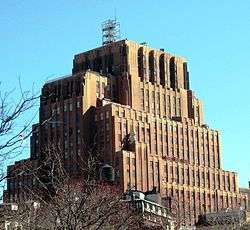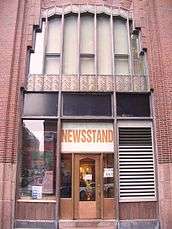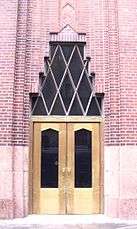60 Hudson Street
Coordinates: 40°43′03″N 74°00′31″W / 40.717593°N 74.00854°W

60 Hudson Street, formerly known as the Western Union Building, is a telecommunications building spanning the entire block between Hudson Street, Thomas Street, Worth Street, and West Broadway in the TriBeCa neighborhood of Manhattan, New York City. It was built in 1928–1930 and was designed by Ralph Walker of the firm of Voorhees, Gmelin and Walker as the headquarters of the Western Union Company, a purpose it served until 1973. The building contained offices, an auditorium, cafeteria and gymnasium, classrooms so messengers could continue their education, shops and equipment rooms, along with 70 million feet of cable.[1][2][3]
The design of the building shows the influence of German Expressionism, while the detailing is Art Deco. The exterior brick moves from darker shades to lighter ones as the building rises, passing through 19 different colors as it does. Both the interior and exterior of the building, which is now one of the most important Internet hubs in the world[4] were designated New York City landmarks in 1991.[2][5]
On February 5, 2016, a 565 foot (172 m)-long boom crane fell from the building onto Worth Street, killing one person and injuring three others,[6][7][8][9] while doing non-structural damage to some of the buildings around it. The crane had been being used to install air conditioning units and generators on the roof of 60 Hudson Steet.[10]
Internet hub
During the heyday of the telegraph, the Western Union Building was a premier nexus of worldwide communications, operating in parallel to the existing Bell Operating Companies of the day. Since Western Union moved its headquarters to New Jersey, the building has been converted into a colocation centre where over 1,000 telecommunications companies interconnect Internet as well as conventional TDM traffic through numerous meet-me rooms and optical and electrical lines placed throughout the building. It is once again a premier nexus of worldwide communications. Metcom Network Services, an example of one such company, has built optical and electrical cabling facilities throughout the building since 1997.[11] An original tenant of Micro-Net, the company that purchased the Western Union assets at 60 Hudson, Metcom provides connectivity throughout the building and between Meet Me Rooms including street cable access and wireless access from numerous microwave and wideband antenna mounts within the rooftop area. Various data centers including Metcom, Equinix, DRT and ZAYO house the worlds largest Internet and Telecommunications providers for the purpose of collocating high capacity transport equipment used to terminate traffic both inbound and outbound with each other.[12] In 2012 equipment for algorithmic trading was installed in buildings close to this one in order to conduct trades microseconds more quickly than in Wall Street a mile away.[13]
In 2006, a New York City panel approved the storage of nearly 2,000 gallons (7,500 liters) of diesel fuel on six floors of the building, part of some 80,000 gallons (300,000 liters) of fuel oil stored in the building. Community opposition had been raised regarding concerns that the presence of the fuel oil posed a fire hazard that could result in a catastrophic failure of the building.[14]
Gallery
 Entrance
Entrance Newsstand entrance
Newsstand entrance Side entrance
Side entrance
See also
References
Notes
- ↑ 60 Hudson Street, Retired Western Union Employees Association. Accessed October 13, 2007.
- 1 2 New York City Landmarks Preservation Commission; Dolkart, Andrew S.; Postal, Matthew A. (2009), Postal, Matthew A., ed., Guide to New York City Landmarks (4th ed.), New York: John Wiley & Sons, ISBN 978-0-470-28963-1 , p.36
- ↑ THE WESTERN UNION BUILDING, NYC Architecture. Accessed October 13, 2007.
- ↑ "One of the Most Important Internet Hubs in the World Is in Manhattan". Gizmodo.com. 2011-11-11. Retrieved 2011-11-16.
- ↑ White, Norval & Willensky, Elliot (2000), AIA Guide to New York City (4th ed.), New York: Three Rivers Press, ISBN 978-0-8129-3107-5 , p.62
- ↑ Brown, Nicole; Reysen, Jamie (2016-02-05). "Cops ID man, 38, killed in crane collapse". am New York. Retrieved 2016-02-06.
- ↑ Tracy, Thomas; Schapiro, Rich; Place, Nathan; Otis, Ginger Adams (2016-02-05). "Construction crane collapse in Manhattan kills David Wichs". New York Daily News. Retrieved 2016-02-06.
- ↑ King, Kate; Shallwani, Pervaiz (2016-02-05). "Crane Collapses in Lower Manhattan, Killing One". Wall Street Journal. Retrieved 2016-02-06.
- ↑ "New York crane collapse kills at least one person". BBC News. Retrieved February 6, 2016.
- ↑ Rojas, Rick and Fitzsimmons, Emma G. (February 5, 2016) "Crane Collapse in Lower Manhattan Kills One Person" The New York Times
- ↑ http://metcom.com
- ↑ Gizmodo. Andrew Tarantola. 11/11/2011 "One of the Most Important Internet Hubs in the World Is in Manhattan"
- ↑ Slavin, Kevin (July 2011) "How Algorithms Shape Our World" TED Talk
- ↑ Cave, Damien. "Waiver Upheld on Location of Fuel Tanks in TriBeCa Building", The New York Times, October 18, 2006. Accessed October 13, 2007.
Bibliography
- Blum, Andrew. Tubes: A Journey to the Center of the Internet, HarperCollins (2012)
External links
| Wikimedia Commons has media related to 60 Hudson Street. |